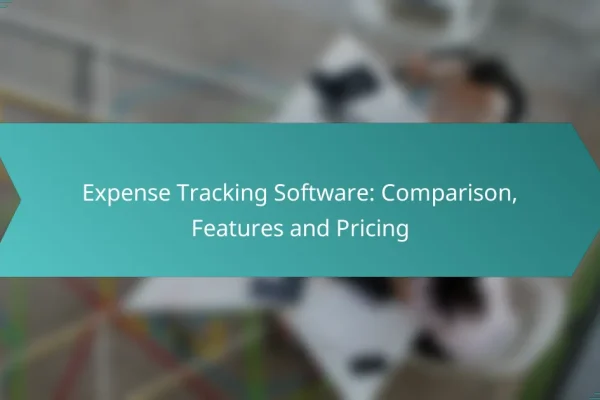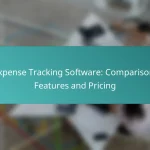What are the best expense tracking tools for corporations?
The best expense tracking tools for corporations streamline the process of managing and monitoring expenses, ensuring accuracy and compliance. These tools offer features like receipt scanning, integration with accounting software, and customizable reporting to enhance financial oversight.
Expensify
Expensify is a popular expense tracking tool that simplifies expense reporting through features like receipt scanning and automatic mileage tracking. Users can easily upload receipts via mobile devices, and the software automatically extracts relevant data, reducing manual entry.
Consider Expensify if your corporation values integration, as it connects seamlessly with accounting platforms like QuickBooks and Xero. Its pricing is flexible, catering to businesses of various sizes, typically ranging from $5 to $9 per user per month.
Zoho Expense
Zoho Expense offers comprehensive expense management solutions, including automated approval workflows and multi-currency support, making it suitable for global corporations. Its user-friendly interface allows employees to submit expenses quickly, while managers can review and approve them efficiently.
This tool is particularly beneficial for companies that need detailed reporting and analytics, as it provides insights into spending patterns. Zoho Expense generally costs around $3 to $5 per user per month, making it an affordable option for many businesses.
QuickBooks Online
QuickBooks Online is primarily known for its accounting capabilities, but it also includes robust expense tracking features. Users can link bank accounts and credit cards to automatically import transactions, simplifying expense management.
For corporations already using QuickBooks for accounting, this integration can save time and reduce errors. Pricing for QuickBooks Online varies, typically starting around $25 per month, depending on the features selected.
Concur
Concur is a leading expense management solution designed for larger corporations that require advanced features like travel booking integration and compliance management. It allows employees to manage travel and expenses in one platform, streamlining processes significantly.
While Concur offers extensive capabilities, it may be more expensive than other options, with costs often exceeding $8 per user per month. Companies should assess their needs carefully to determine if the investment aligns with their expense management goals.
FreshBooks
FreshBooks is an intuitive accounting software that includes expense tracking as part of its suite. It allows users to categorize expenses, upload receipts, and generate reports easily, making it suitable for small to medium-sized corporations.
The platform is known for its user-friendly design and customer support, which can be beneficial for teams new to expense management tools. FreshBooks pricing starts around $15 per month, offering a cost-effective solution for businesses looking to manage expenses efficiently.
How do expense tracking tools improve financial management?
Expense tracking tools enhance financial management by providing businesses with accurate, real-time insights into spending. These tools help organizations monitor expenses, streamline processes, and ensure compliance with budgets and policies.
Real-time expense visibility
Real-time expense visibility allows companies to track expenditures as they occur, providing up-to-date information on spending patterns. This immediate access helps identify potential overspending and enables timely adjustments to budgets.
For instance, businesses can set spending alerts that notify managers when expenses approach budget limits. This proactive approach can prevent financial discrepancies and ensure better resource allocation.
Streamlined approval processes
Streamlined approval processes reduce the time and effort required to authorize expenses. By automating workflows, expense tracking tools facilitate quicker approvals, allowing employees to submit expenses digitally and managers to review them efficiently.
Many tools offer customizable approval hierarchies, ensuring that the right people review expenses based on predefined criteria. This not only speeds up the process but also enhances accountability within the organization.
Automated reporting
Automated reporting simplifies the generation of financial reports by compiling data from various sources into a cohesive format. This feature saves time and reduces errors associated with manual data entry, providing accurate insights into spending trends.
Expense tracking tools often include customizable reporting options, allowing businesses to create reports that meet specific needs. Regularly scheduled reports can help management make informed decisions based on current financial data.
What features should I look for in expense tracking tools?
When selecting expense tracking tools, prioritize features that enhance usability, integration, and efficiency. Key functionalities include mobile app accessibility, integration with accounting software, customizable expense categories, and receipt scanning capabilities.
Mobile app accessibility
Mobile app accessibility is crucial for tracking expenses on the go. Look for tools that offer user-friendly apps compatible with both iOS and Android devices. This allows employees to submit expenses in real-time, reducing delays and improving accuracy.
Consider tools that provide offline functionality, enabling users to log expenses without an internet connection. This feature is particularly useful for business trips in areas with limited connectivity.
Integration with accounting software
Seamless integration with accounting software simplifies the financial management process. Choose expense tracking tools that can connect with popular platforms like QuickBooks, Xero, or FreshBooks. This integration minimizes manual data entry and reduces the risk of errors.
Evaluate whether the tool supports automatic syncing of expense data to your accounting system. This feature can save significant time during month-end reconciliations and financial reporting.
Customizable expense categories
Customizable expense categories allow businesses to tailor their tracking according to specific needs. Look for tools that enable you to create and modify categories to reflect your organization’s unique expense types, such as travel, meals, or office supplies.
This flexibility helps in generating more accurate reports and analyzing spending patterns. It also ensures that employees understand where to categorize their expenses, leading to better compliance and reporting accuracy.
Receipt scanning capabilities
Receipt scanning capabilities streamline the expense reporting process by allowing users to capture and upload receipts directly through the app. Look for tools that utilize OCR (Optical Character Recognition) technology to automatically extract relevant information from receipts.
This feature can significantly reduce the time spent on manual entry and improve the accuracy of expense reports. Additionally, ensure the tool provides a secure way to store scanned receipts, which is essential for audit trails and compliance with tax regulations.
How do I choose the right expense tracking tool for my business?
To choose the right expense tracking tool for your business, assess your specific needs, budget, and the ease of use of the software. A well-suited tool will streamline your expense management process and enhance financial oversight.
Assess company size and needs
Understanding your company size and unique requirements is crucial in selecting an expense tracking tool. Small businesses may benefit from simpler, cost-effective solutions, while larger enterprises might require more robust features like multi-currency support and advanced reporting capabilities.
Consider the number of employees who will use the tool and the volume of transactions processed. For instance, a company with a handful of employees may find a basic app sufficient, while a larger organization may need a comprehensive system that integrates with existing financial software.
Evaluate budget constraints
Your budget plays a significant role in choosing an expense tracking tool. Many options are available, ranging from free applications to premium software that can cost hundreds of dollars monthly. Determine how much you can allocate for this tool without compromising other essential business expenses.
Look for tools that offer a free trial or tiered pricing models. This allows you to test the software before committing financially. Be cautious of hidden fees, such as those for additional users or premium features, which can quickly escalate costs.
Consider user-friendliness
User-friendliness is vital for ensuring that your team can adopt the expense tracking tool without extensive training. A straightforward interface and intuitive navigation can significantly reduce the time spent on expense reporting and approval processes.
Seek tools that offer mobile applications, as this can enhance accessibility for employees who are often on the go. Read user reviews and consider conducting a demo to assess how easy the tool is to use before making a final decision.
What are the pricing models for expense tracking tools?
Expense tracking tools typically employ various pricing models, including subscription-based pricing, pay-per-use models, and free trial options. Understanding these models helps businesses choose the right tool based on their usage patterns and budget constraints.
Subscription-based pricing
Subscription-based pricing is a common model where users pay a recurring fee, often monthly or annually, to access the software. This model usually includes different tiers, offering varying features and user limits, which allows companies to select a plan that fits their needs.
For example, a small business might opt for a basic plan at around $10 to $30 per month, while larger enterprises may require more comprehensive plans costing $100 or more monthly. This model provides predictable costs but may lead to higher expenses if the tool is underutilized.
Pay-per-use models
Pay-per-use models charge users based on their actual usage of the expense tracking tool. This can be beneficial for businesses with fluctuating needs, as they only pay for what they use, making it a flexible option.
For instance, a company might pay a fee for each expense report submitted or a small percentage of the total expenses processed. This model can be cost-effective for companies that do not have consistent expense tracking needs but may become expensive if usage increases significantly.
Free trial options
Many expense tracking tools offer free trial options, allowing users to test the software before committing to a paid plan. These trials typically last from a week to a month and provide access to most features, enabling businesses to evaluate the tool’s effectiveness.
During the trial, companies should assess the tool’s usability, integration capabilities, and customer support. However, it is crucial to read the terms, as some trials may automatically convert to paid subscriptions if not canceled in time.
What are the common challenges in corporate expense management?
Corporate expense management often faces challenges such as lack of visibility, compliance issues, and inefficient processes. These obstacles can lead to overspending, inaccurate reporting, and employee dissatisfaction.
Visibility and Transparency
One major challenge in expense management is achieving visibility and transparency across all spending. Organizations need to track expenses in real-time to identify trends and anomalies. Without proper tools, it can be difficult to monitor spending patterns, leading to budget overruns.
To enhance visibility, companies should implement centralized expense tracking systems that allow for easy access to data. This can help stakeholders understand where money is being spent and make informed decisions.
Compliance and Policy Adherence
Ensuring compliance with internal policies and external regulations is another significant challenge. Employees may not always be aware of the rules regarding expense submissions, leading to errors or fraudulent claims. This can result in financial penalties and damage to the company’s reputation.
To mitigate compliance risks, organizations should provide clear guidelines and regular training for employees. Automated expense management tools can also help enforce policies by flagging non-compliant submissions.
Efficiency in Expense Reporting
Many companies struggle with inefficient expense reporting processes, which can be time-consuming and prone to errors. Manual entry of expenses often leads to inaccuracies and delays in reimbursement, causing frustration among employees.
Adopting digital expense management solutions can streamline reporting. Features like receipt scanning and automated categorization can significantly reduce the time spent on expense submissions, allowing employees to focus on their core responsibilities.






